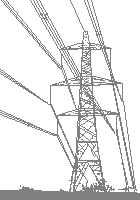
The intitial practical applications of electric power utilised direct current and the first attempts at transmission of electricity utilised a pair of conductors, one carrying the direct current from the positive terminal of the generator to the load and another completing the circuit back to the negative terminal of the generator.
|
The energy which is lost in the transmission cable (or any other conductor) is given by the product of the voltage drop along it and the current carried. It is also directly proportional to the length of the cable and inversely proportional to its cross-sectional area. To decrease the loss it is necessary to decrease the length of the thransmission cable or increase its cross-sectional area - both options being impractical. |
As power is the product of voltage and current, increasing the voltage would result in in the reduction of the current carried for a given power and consequently a reduction in the size of tranmission cable required to carry the power. It was therefore desirable to transmit electrical power at higher voltages but these were limited by the safe voltage which could be delivered to the consumer.
While experience was being gained in the practical distbution of direct current, it soon became evident that there were advantages to distubuting alternating current.
The transformer allowed alternating current generated at low voltages to be "stepped up" to high voltages for economical transmission and to be "stepped down" by local transformers for delivery to the consumer. As with the original direct current installations, the first alternating current systems utilised two cables for "single phase" transmission.
|
In 1889, an experimental double cable was laid in London from Deptford to Bond Street and back - a distance of about twelve miles. A step-up transformer delivered 7,240 volts to the transmission line and a step-down transformer supplied loads at normal voltages. Both the generatng equipment and the load were located nearby eachother to facilitate the study of the properties of the "transmision line" by Ferranti. Amongst Ferranti's discoveries were that an increase in current or load tranmitted along the line resulted in a decrease in voltage at the load end. Also, when no power was transmitted, the voltage at the load end was than that at the generator end. This effect is due to the capacitance of the transmission line and the effects are most noticeable on long lines; the voltage at the load end of a 240-mile long transmission line supplied at 150,000 volts is 10% (15,000 volts) higher than the generated voltage when there is no load. This effect is even more pronounced in with underground cables but these are uneconomical for long-distance transmission. |
A three-phase transmission system was introduced by Tesla in 1890 - with a three-phase system, almost twice the power can be delivered through a conductor only 1.5 times the cross-sectional area of a single phase system.
The conditions for efficient, practicable and economical transmission of electrical power are
that the electricity is produced on a large scale
it is produced continuously
it is transmitted at high voltages
distributed at low voltage
The Central Electricity Board was established in 1926 and developed the National Grid System for distribution of electricity.
The location of large central generating stations are determined by the location of consumers to be served, the cost of transmission and distribution, the availability of fuel and water supplies. Capacity is determined by the anticipated load and the proximity of other generating stations.
The alternating current produced at the generator is stepped up to 132,000 volts (132 kV) and distributed to local sub-stations by overhead "high tension" lines. Local transformers located around sub-stations at locations convenient for the supply of the consumer step down the voltage for delivery to the consumer.
Generation
The state-owned Central Electricity Generating Board which generated and transmitted all publicly supplied electricity in England and Wales was restructured and privatised in 1990. Generation was split between National Power and PowerGen and Nuclear Electric while the National Grid took over distribution.
Transmission
The National Grid and Lattice (the holding company for Transco the owner operator and developer of the substantial majority of Britain's natural gas transportation system) merged to form National Grid Transco on October 21st, 2002.
At April 31st, 2003, National Grid Transco owned and operated 4,500 miles of high-voltage electricity transmission overhead line in England and Wales, 400 miles of high-voltage electricity transmission underground cable and 340 substations.
|
| | | A massive blackout in the USA and Canada on Thursday, August 14th, 2003 leaving some 50-million consumers without electricity prompted questions about whether such an event could happen in the UK.
National Grid Transco warned that it could not guarantee power throughout the country during the peak season of 21 weeks starting in October.
Not only is the distribution system working at near its full capacity, but the break-up of the generating industry and lowering of wholesale electricity prices has led to the closure of many generating stations. It is possible that it would not be possible to compensate for the loss of a major generating plant and then substations would automatically switch power off to protect the distribution grid.
|
| |
| | |
|
| | | Links to Other Pages on this Site
|
| |
| | |
|
| | | Links to Other Sites
|
| |
| | |
|
| | | Links to Other Pages on this Site
|
| |
| | |
Hits on this page since December 6th| Jan | | |  | | Feb | | |  | | Mar | | |  | | Apr | | |  | | May | | |  | | Jun | | |  | | Jul | | |  | | Aug | | |  | | Sep | | |  | | Oct | | |  | | Nov | | | | | Dec | | |  |
current year:  | | previous year:  |
No messages posted on this page Only Members of the Site can post messages in this section. Signing in is easy from our Home Page. DISCLAIMER: Whilst we endeavour to ensure the content of this site is correct, we cannot undertake that information you find here, is, or will remain accurate and complete. We do not warrant that any information contained on this site is fit for any purpose. If you wish to place reliance on any such information you must check its accuracy by some other means before doing so. MEMBERS get aditional features on our pages and will soon be able to interact with the site and add their views and informastion. Sign up, from the Home-Page, is simple and involves typing in your email address and a password of your choice. If you are in any way connected with any location or interested in the subject mentioned on this page and have an hour or two a month to spare, we would welcome you as a local moderator - please email the webmaster by CLICKING HERE. Privacy Policy
|
|







